Nutrition of Florida Citrus Trees, 3rd Edition: Chapter 2. Production Areas, Soils, and Land Preparation
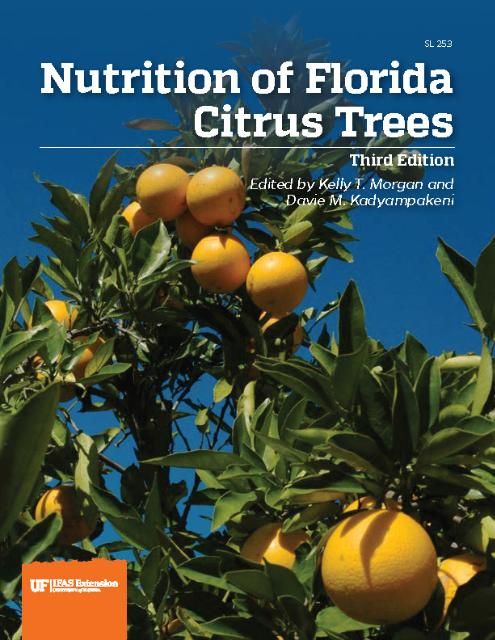
This publication is part of SL253, Nutrition of Florida Citrus Trees, 3rd Edition. For references, a glossary, and appendices, please refer to the full document at https://edis.ifas.ufl.edu/ss478.
Information in the box below applies to citrus trees affected by HLB. Other information in this chapter is valid for healthy citrus trees and trees with HLB.
Recommendations for HLB-affected trees:
Soil pH Management—Kelly Morgan, Jim Graham, and Fernando Alferez.
Because HLB symptoms worsen in groves irrigated with wells and surface water containing dissolved bicarbonates, pH management should be adopted to maintain pH in the same 6.0–6.5 range. This is because high pH reduces availability of Ca, Mg, Fe, Zn, and Mn. In groves with high bicarbonate levels, feeder root density and root lifespan decrease and function in nutrient uptake is reduced. However, not all rootstocks are equally sensitive; Swingle is the most sensitive. Soil and water quality should be managed by a frequent application of water and nutrients to the reduced root system by the effect of HLB. This can be achieved by water conditioning with N-phuric acid or sulfuric acid, or by soil conditioning with sulfur in the wetted zone, where microjet irrigation concentrates bicarbonates. More detailed information is given in chapters 8 and 9.
With HLB incidence close to 100% in Florida, efforts should be made to make nutrients more available to the weakened root system, and for this, pH should be maintained between 6.0 and 6.5. This ultimately would result in reduction of stress on feeder roots and would increase nutrient uptake and root longevity with improved color and vigor in foliage.
Soil Organic Matter Management—Fernando Alferez
Because of its benefits to soil fertility and its increased availability since the mid-1990s, organic matter addition has become more practical. This is especially true in the case of HLB-affected trees. In poor and depleted soils that are low in organic matter, addition of compost has clear benefits: soil structure improvement, higher water- and nutrient-holding capacity, an additional nutrient source, decreased soil erosion, insulating properties against heat and cold, buffer soil pH, good aeration (which results in better root growth), and an increase in populations of beneficial microorganisms and earthworms.
Composting can be an important part of a Best Management Practices program to minimize N and P losses because it has the potential to enhance root health by providing a complex, slow release carbon source to feed beneficial soil microorganisms. Compost can be applied any time after the trees are established. However, the best benefits will be achieved when composting is done as a part of the land preparation. If trees are already planted, composting should be done at shallow depth to avoid root damage.
General Information
Florida soils are not particularly favorable for management of water and agrichemicals. Most Florida citrus is grown on naturally infertile soils that are unable to retain more than a minimal amount of soluble plant nutrients against leaching by rainfall or excessive irrigation. Florida citrus soils range from well-drained Entisols on relatively high, rolling landscapes to poorly drained Alfisols and Spodosols on low-lying Flatwoods (Figure 1). The root zones of these soils are dominated by sand and contain only minor quantities of silt, clay, and organic matter, which make the management of water and nutrients a challenging task for grove managers.

Well-drained soils are found through the central part of the Florida peninsula as far south as Highlands County on the central Florida Ridge. Their main advantages are good drainage, good aeration, and a deep root zone. The main disadvantage is the need for frequent irrigation during dry periods. Soil uniformity, lack of hardpan, and a low water table allow for deep, extensive root systems. Such an extensive rooting zone enables the tree to overcome the low water- and nutrient-holding capacity of these soils to some extent.
Poorly drained soils are found in coastal areas and on the Flatwoods of central and south Florida. The soils on the east coast usually are naturally acidic with a subsurface hardpan, but some may have marl or shell in the profile that makes them alkaline. The water table is close to the surface and the soil may pond during the wet season. These soils must be drained and bedded before planting citrus. Their principal advantages are higher natural fertility and water-holding capacity. Disadvantages include poor drainage and increased alkalinity or clay content of the surface layer due to deposition of subsurface materials over the natural surface during the bedding process.
Characteristics of Soil Orders Important to Florida Citrus Production
A soil order is the most basic category of soil classification and gives a general idea about some of the physical and chemical characteristics of a soil. For Florida citrus soil orders, characteristics important to production are described below.
- Entisols are sandy mineral soils low in organic matter, natural fertility, and water-holding capacity (Figure 2). They have weak or no diagnostic subsurface layers and are well to excessively well drained.
- Spodosols are sandy mineral soils low in organic matter and natural fertility in the surface layer (Figure 3). They contain an acidic subsurface restrictive layer composed of aluminum and iron "cemented" together with organic matter.
- Alfisols are sandy mineral soils low in organic matter in the surface layer but higher in relative natural fertility compared with Spodosols (Figure 4). They contain a subsurface layer of loamy material (a mixture of mostly clay and sand with little silt) that has a relatively high water-holding capacity.
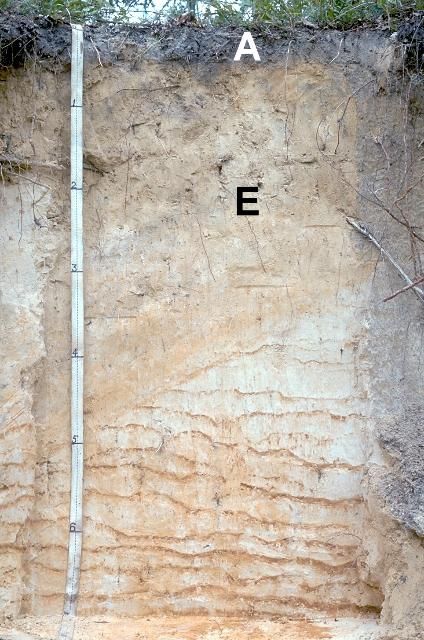
Credit: Mary Collins, UF/IFAS
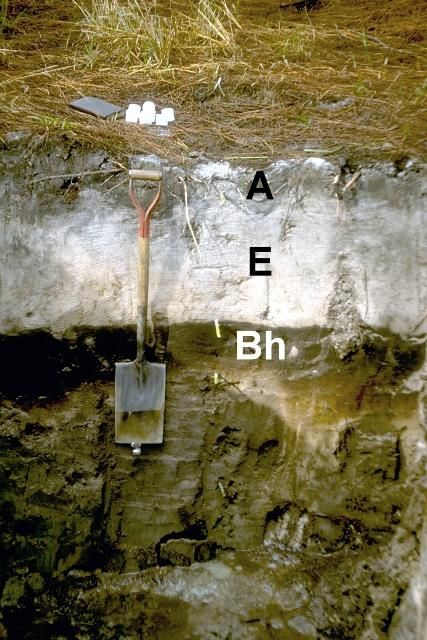
Credit: Mary Collins, UF/IFAS
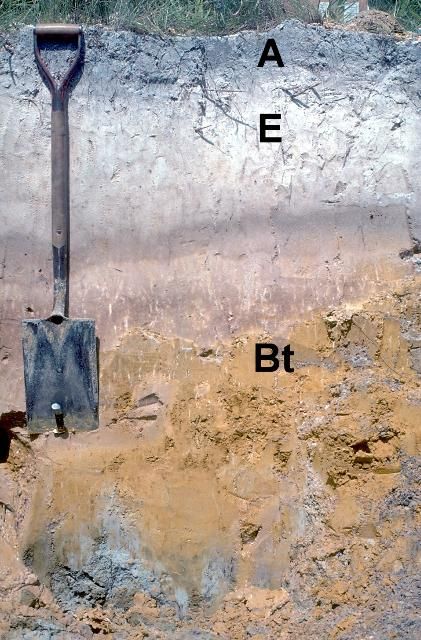
Credit: Mary Collins, UF/IFAS
Soil Series Typically Found in Citrus Groves
A soil series is the most specific category of soil classification. There are 15 soil series that represent most of the soils on which Florida citrus groves have been planted (Table 1). Entisols (other than Basinger) occur on high Ridges and upland plains at an elevation greater than 100 ft above mean sea level in the central Ridge production area. Alfisols, Spodosols, and the Basinger series occur on broad, low flat areas or in sloughs at elevations from 10 to 40 ft in the Gulf and Indian River production areas, and 35 to 100 ft in the Peace River production area. Some Alfisols and Spodosols can also occur in depressional areas, even though they are normally located higher on the landscape.
Soil Physical and Chemical Properties Important to Citrus Nutrient Management
The soil on which citrus is grown greatly influences how irrigation water and nutrients should be managed to maximize production, minimize resource use, and protect water quality. Soil properties important to nutrient management include texture, water-holding capacity, organic matter content, soil pH, cation exchange capacity, and coatings on sand grains (see Appendix A).
- Soil texture is the relative proportion of sand, silt, and clay in a mineral soil. Texture influences how much water a soil can hold against drainage by gravity and how quickly water will drain away. Most citrus soils contain 94% to 98% sand in the root zone, which makes irrigation water management extremely difficult because sand has little capacity to hold water. If too much irrigation water is applied at one time, the excess will be lost below the root zone, which can induce nutrient leaching.
- Soil organic matter includes any organic carbon-based material, from freshly deposited plant residues to highly decomposed humus or compost. In their native state, typical citrus soils may contain as much as 5% organic matter, but after a grove is planted organic matter decreases, eventually stabilizing around 1% or 2% by the time the grove matures. In general, the more chronically wet a citrus soil is, the higher its organic matter content tends to be. Soil organic matter is rapidly lost by oxidation to carbon dioxide in Florida's warm and humid climate, and it is not replaced in large quantities by citrus trees. Use of herbicides beneath tree canopies also decreases organic matter accumulation. In a sandy soil, organic matter is an extremely valuable component because it provides both water- and nutrient-holding capacity, and its decomposition provides recycled nutrients to plants.
- Soil water-holding capacity is directly related to the amount of silt, clay, and organic matter present. Because most Florida citrus soils contain only small amounts of these components, water-holding capacity is rarely greater than 1 inch per foot of soil depth, and is often less than 0.75 inches per foot. Low water-holding capacity soils require light and frequent irrigation to minimize nutrient leaching.
- Soil pH affects the availability of plant nutrients, including P, Ca, Mg, and the micronutrients. Most Florida soils are acidic in their native state, so they require lime applications before planting and every few years thereafter, depending on fertilizer and irrigation water sources. The optimum soil pH range for citrus is 6.0 to 6.5. The pH of Florida citrus soils can change rapidly as a result of chemical reactions caused by lime or fertilizer applications. An exception to this tenet is a calcareous soil. Some of the Alfisols in Table 1 can be calcareous due to a substratum of natural calcium carbonate rock or shell that dominates their chemistry. The pH of a calcareous soil remains relatively constant around 8.2.
- Cation exchange capacity (CEC) is a measure of the ability of the soil to hold positively charged nutrients like Ca, Mg, K, and ammonium-N (NH4+) against leaching (Figure 5). Generally speaking, as CEC increases, soil fertility increases. Soil CEC is supplied by clay and organic matter. Florida citrus soils are low in CEC, so nutrient management is difficult. The best fertilizer use efficiency can be obtained by applying mobile nutrients like N and K frequently in small doses, similar to irrigation water. Entisols are the least fertile citrus soils, followed by Spodosols and Alfisols. The increased fertility of Spodosols reflects their slightly higher organic matter content, while the fertility of Alfisols is greatest because they contain some clay as well as organic matter.
- Coated and noncoated sands relate to the P fixation capacity of Florida soils, which is important because the movement of P from agricultural fields to surface water bodies has become an environmental concern. Most soils nationwide have a moderate to high capacity to adsorb or hold soil P against leaching because they contain considerable quantities of silt and clay that provide a chemical mechanism to bind P. Florida soils dominated by quartz sand lack appreciable amounts of these silts and clays. However, in many cases the sand particles are coated with iron and/or aluminum compounds that also have some capacity to adsorb P.
One way to judge if coated sand grains are present is to observe the soil color (Figure 6). Yellow, orange, or brown sand is more likely to be coated, while bright white sand is not. Therefore, citrus groves on soils containing coated sands have the ability to build up a soil P reserve following P fertilizer applications. The presence of this P reserve can be determined with soil testing, and P fertilization should be curtailed if high soil test P is found. Conversely, citrus groves on noncoated sandy soils lack the ability to hold P. In this case excessive P fertilization may induce P leaching, so P fertilizer should not be used indiscriminately because it may be lost to the environment.
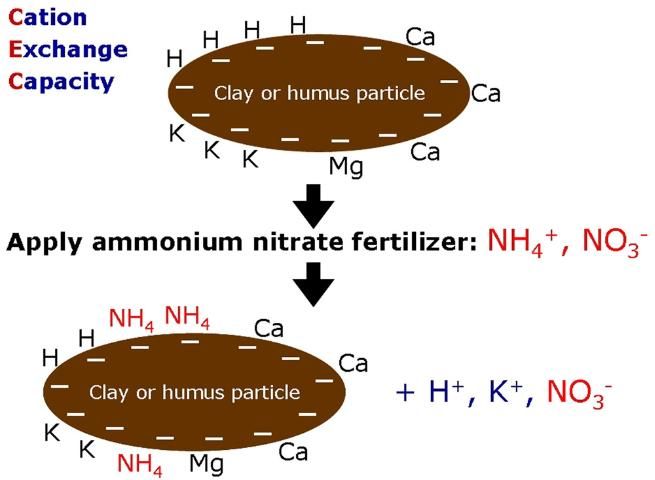
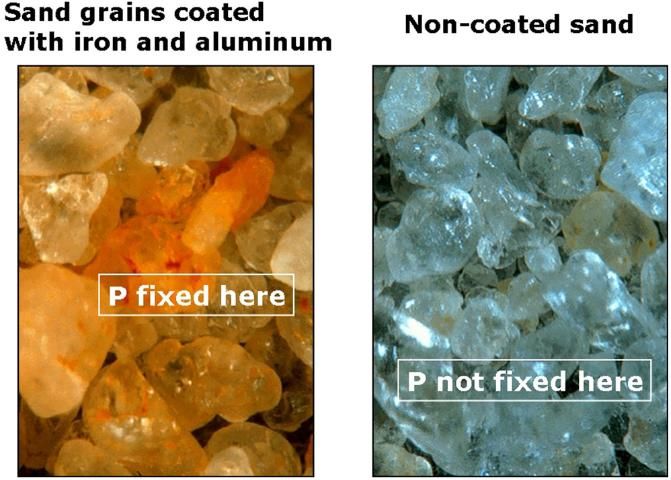
Vulnerable Soils
The presence of fertilizer and agricultural chemicals in groundwater has become an issue in a number of agricultural production areas around the world. More than half of the total fresh water used in Florida comes from groundwater, and more than 90% of the public relies on groundwater supplies for drinking.
Of all fresh water withdrawn in Florida, one-third is consumed and two-thirds is returned to the groundwater. The quality of this water is important because it may come in contact with soluble nutrients, pesticides, or heavy metals prior to returning to the surficial aquifer or flowing off site. Florida's unique hydrogeologic features, including a thin surface soil layer, high water table, and porous limestone in many areas, make the soil susceptible to downward movement of nutrients. Soils used for citrus production on the central Ridge are particularly subject to leaching and are referred to as vulnerable soils (Figure 7). These soils are well drained with low organic matter and provide ideal conditions for leaching of plant nutrients, including soil-applied N fertilizer. Removal of N by denitrification is minimal in these soils.
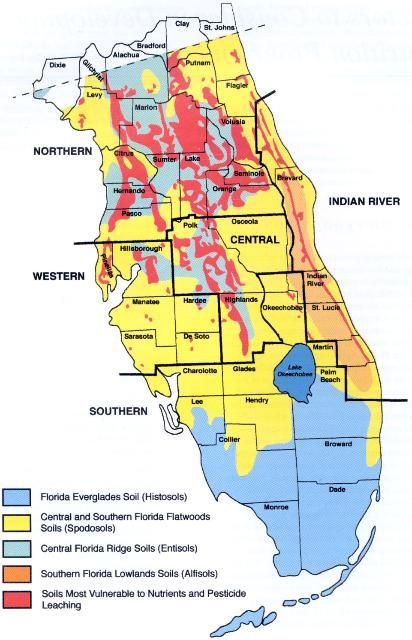
Credit: James Turk and Juan Vega, USDA-NRCS, Gainesville
The soils in Table 2 have been categorized by the Florida Department of Agriculture and Consumer Services (based on USDA-Natural Resource Conservation Service information) as highly permeable and well drained and, therefore, at risk in terms of groundwater contamination through agrichemical leaching. Although such soils dominate throughout the Ridge citrus production area, many are scattered throughout other Florida citrus producing areas. Consult your local NRCS office or county soil survey to determine if a grove contains one or more vulnerable soils. County soil surveys can be viewed on the NRCS web site at http://websoilsurvey.nrcs.usda.gov/app/.
Grove Site Selection and Land Preparation
When developing a grove site, it is important to determine general soil fertility by testing the soil for pH, organic matter, and Mehlich 1 (double-acid) extractable P, Ca, and Mg. If the site has been previously used to grow citrus or vegetables, extractable Cu concentration should also be checked.
If the soil is found to be acidic (pH 5.3 or less), the pH should be raised to the 5.5 to 6.5 range by adding lime. The higher target pH should be used for soils with Mehlich 1–extractable Cu greater than 25 mg/kg (ppm).
Renovating old Flatwoods groves by rebedding and ditching can have profound effects on fertility, water relations, and tree rooting volume. Often the renovation is beneficial, but problems may occur in some cases if high pH materials or clay are brought up into the rooting zone. An increasingly important factor to consider, especially in the HLB era, is drainage. Although this is not an issue in central Florida sandy soils, in the eastern and southwestern production areas of the state, drainage systems are required. Examples of these drainage systems are water furrows, ditches, and tile drains, combined with raised beds. Because most Flatwood soils have a restrictive layer that may affect tree water relations by perching the water table, this should be monitored frequently for adopting adequate irrigation and drainage decisions.
Effects of Leveling and Bedding on Soil Fertility in Flatwoods Citrus Groves
In contrast to central Ridge citrus groves that are planted along the natural contour of the land, Flatwoods grove sites must be leveled, slightly sloped, and bedded before planting to provide artificial drainage. The topsoil of native Alfisols and Spodosols is no more than 6 to 8 inches thick. Below this layer is the first subsoil layer, which is usually white or light gray sand that is extremely low in fertility and water-holding capacity. Occasionally, land leveling removes all of the topsoil from a higher part of the field and transports it to a lower part, leaving the light-colored sandy subsoil as the new surface (Figure 8). Citrus tree growth and production in these areas (commonly referred to by Flatwoods citrus growers as scraped areas or sand ponds) is usually poor.
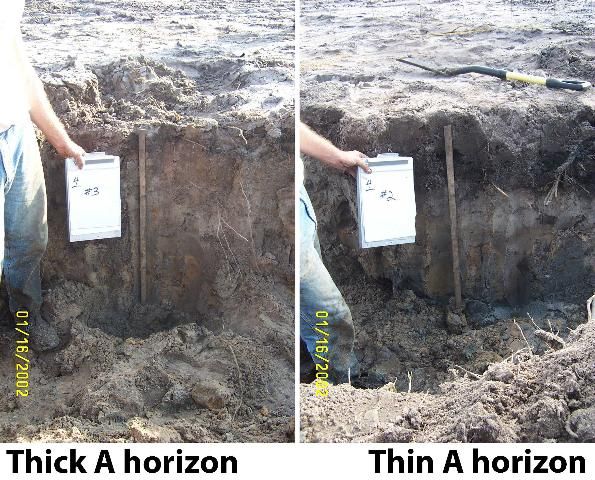
Credit: Mace Bauer, UF/IFAS
After leveling, soil beds are constructed by cutting parallel wide and shallow V-shaped furrows about 50 ft apart. The soil removed from these furrows is shaped into a convex bed between them on which the citrus trees are planted. The vertical distance from the bottom of the furrow to the top of the bed is usually about 2 to 3 feet. When constructing beds, the original soil surface is covered by subsoil that may have significantly different physical or chemical characteristics than the surface soil. The overburden soil can be either coarser or finer-textured than the surface soil, but it is almost always lower in organic matter. If the soil series has limestone in the profile, the overburden may be calcareous. Therefore, the root zone soils in bedded groves are often less fertile and lower in water-holding capacity compared with the buried original surface layer.
The restrictive subsurface layer in Flatwoods soils can affect citrus production in two ways. If it is relatively deep, it remains intact after bedding and will impede downward water percolation. Citrus rooting can be affected by this layer due to its influence on shallow water table depth and duration. Typically, almost all Flatwoods citrus roots reside in the top 18 inches of soil due to the effect of the restrictive layer.
Some Flatwoods soils have relatively shallow restrictive layers that can be excavated during the bedding process, so these subsurface materials are sometimes mixed into the root zone. The chemical and physical properties of a restrictive layer differ substantially from the sandy surface layer (Appendix A). Material from a loamy (Bt) layer is higher in clay, while a sandy dark red, brown, or black (Bh) layer is higher in organic matter. Loamy layers can be either acidic or alkaline in pH, while organic-stained layers are always highly acidic. In addition, water-holding and cation exchange capacities are higher in restrictive layers. The magnitude of influence that soil from these layers might have on root zone soil properties is directly related to the amount of material that was excavated and mixed in during bedding.
Soil pH and Liming
Soil pH measures soil acidity or alkalinity and is used to make liming decisions. Soil pH measurement is quick, easy, and inexpensive. Soil pH control is important because the availability of most plant nutrients, as well as of those nutrients that are toxic to plants, is affected by it. If soil pH is too low, the Adams-Evans Buffer pH test determines the rate of lime needed to raise it to 6.5.
Irrigation water from Florida's deep aquifers frequently contains dissolved limestone that can slowly raise soil pH. Higher soil pH is particularly evident in the areas wetted by microirrigation emitters. Florida soils vary considerably in Ca content. The majority of soil Ca exists as sparingly soluble minerals, including Ca-phosphates and Ca-carbonate. Calcium must dissolve from these compounds to become plant-available. Florida's coarse-textured soils are low in Ca because they are mostly quartz sand. On the other hand, calcareous soils are extremely high in Ca. Calcium in soils may be classified as non-exchangeable (mineral forms), exchangeable (adsorbed to clay or organic matter colloids), or soil solution Ca. Exchangeable Ca is the major Ca reserve in soils that is available to plant roots. Calcium availability is largely a factor of the supply in the soil.
The target pH of 6.0 for Florida citrus production is based on a study of pH and Ca interactions conducted on a Ridge soil (Candler fine sand). A clear advantage of pH 6.0 over pH 5.0 was evident, and pH 7.0 was no better than pH 6.0 at all Ca concentrations. Therefore, if a soil test does not show excessive Cu accumulation, a soil pH of 6.0 is sufficient for citrus production. Soil pH should be raised to 6.5 when soil tests show a buildup of Cu.
Soil pH can be increased by applying either calcitic or dolomitic lime. In addition to affecting soil pH, calcite is an effective source of Ca, whereas dolomite supplies both Ca and Mg. Therefore, although either calcite or dolomite could be effectively used for citrus production, the choice of dolomite would be more appropriate for soils that also require Mg.
In groves with favorable soil pH but low soil Ca, gypsum can be used as a source of available Ca. In most bearing groves, soil pH is generally above 6.0, so liming would not be required. Gypsum is an alternate source of Ca with no effect on soil pH. Although the application of dolomite can alleviate Mg deficiency, tree response is usually slow. Application of dolomite as a source of Mg is not recommended if the soil pH is in the desired range. Under this condition, applying MgSO4 or MgO to the soil or Mg(NO3)2 as a foliar spray can correct Mg deficiency.
The current soil pH recommendations for nonbearing and bearing citrus take into account: 1) higher pH soils now in production, 2) the high pH of groundwater used for irrigation, 3) greater use of rootstocks like Swingle citrumelo that grow poorly in high pH soils, and 4) widespread field observations relating to increased blight incidence under higher pH and/or Ca soil conditions.
Organic Matter
As discussed earlier, organic matter is an extremely valuable component of sandy soils because it provides both water- and nutrient-holding capacity, and its decomposition provides recycled nutrients to plants. The opportunity to add imported organic matter to a citrus grove is greatest prior to planting because it can be more readily applied and incorporated into the soil where the tree rows will be located.
Florida citrus has been successfully grown for decades without external organic matter addition, so it historically has not been a necessary practice. However, because of its benefits to soil fertility and its increased availability since the mid-1990s, organic matter addition has become more practical. Florida landfills no longer accept horticultural waste, so some county waste disposal operations have turned to mulching or composting for disposal. These materials are usually provided to consumers at no cost other than transportation. Materials intended as mulches are not recommended for application to citrus groves as soil amendments because they may rob N from trees as they decompose. Finished compost is appropriate for immediate soil application, but mulch would need to be composted on site before it would be safe to incorporate it.
There is no particular target rate for composted organic matter application. A general rule is, some is better than none, and more is better than less. A grower's decision to apply organic matter should be based on the proximity of a suitable supply and the cost to transport, spread, and incorporate it. Because of the large volumes required for meaningful application rates (e.g., 10 to 50 tons/treated acre), uniform application of a lower rate across an entire grove is not recommended. Rather, the grower should identify the weaker soils in the grove and concentrate higher rates of organic matter application in those areas.
Ozores-Hampton et al. (1998) suggested optimum physical and chemical properties for compost applied to agricultural land:
- 35% to 55% moisture by weight.
- 50% or more organic carbon.
- pH between 5.0 and 8.0.
- 20% to 60% water-holding capacity by weight.
- Less than 6.0 dS/m soluble salts.
- 500 to 1000 lb/yd3 fresh bulk density.
- Particle size passes 1-inch screen.
- 15:1 to 25:1 C-to-N ratio.
- No viable weed seeds.
Of these characteristics, the two most important are C-to-N ratio and soluble salts. Lower values of each indicate compost more favorable for application to a Florida citrus grove.




